¿Alguna vez has olvidado la llave de tu casa y te has quedado afuera? Quedarte fuera de tu sitio web de WordPress puede sentirse muy parecido. Es súper frustrante, especialmente si los hackers eliminaron tu cuenta de administrador. Pero no te preocupes, puedes volver a entrar.
Piensa en tu sitio web como una casa con una puerta trasera secreta. Esa puerta trasera es la base de datos de tu sitio web, y generalmente se accede a ella usando código MySQL. Ahora, eso puede sonar complicado, pero es como un conjunto de instrucciones que puedes usar para hacer cambios en tu sitio web detrás de escena.
En este artículo, te enseñaremos cómo usar MySQL para crear una cuenta de administrador completamente nueva para tu sitio web, como si hicieras una llave nueva para tu casa. De esa manera, puedes bloquear a los hackers y recuperar el control.
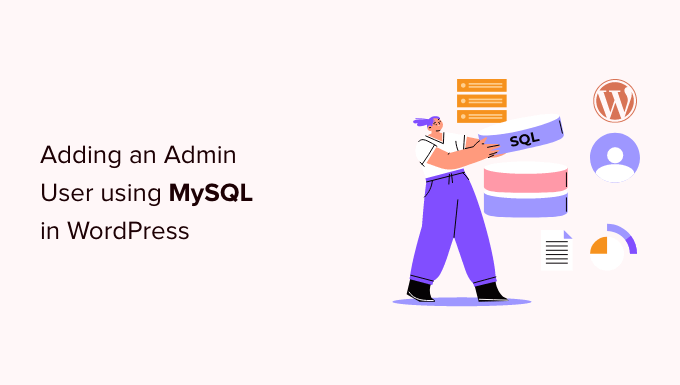
¿Por qué agregar un usuario administrador a la base de datos de WordPress a través de MySQL?
Una vez nos encontramos con un problema donde el sitio de un usuario fue hackeado y su cuenta de administrador fue eliminada de la base de datos. Esto los dejó fuera de su sitio web de WordPress.
Pudimos ayudarles a obtener acceso a su sitio web creando un nuevo usuario administrador directamente en el sitio web de WordPress. Lo hicimos usando phpMyAdmin, una herramienta basada en web que te permite administrar bases de datos MySQL usando tu navegador web.
Si te encuentras bloqueado del área de administración de WordPress debido a hackers o simplemente porque olvidaste tu contraseña, entonces puedes hacer lo mismo.
Sin embargo, siempre debes hacer una copia de seguridad de tu base de datos antes de realizar cualquier edición de MySQL. Luego, una vez que puedas volver a iniciar sesión en tu sitio web, es posible que necesites seguir nuestra guía para principiantes para arreglar tu sitio de WordPress hackeado.
Dicho esto, veamos cómo agregar un usuario administrador a la base de datos de WordPress a través de MySQL.
Agregar un usuario administrador a la base de datos de WordPress con phpMyAdmin
phpMyAdmin viene preinstalado con la mayoría de las empresas de hosting de WordPress más importantes. Puedes encontrarlo en la sección Bases de datos del panel de control cPanel de tu cuenta de hosting.
Aquí hay una captura de pantalla del panel de control de Bluehost:
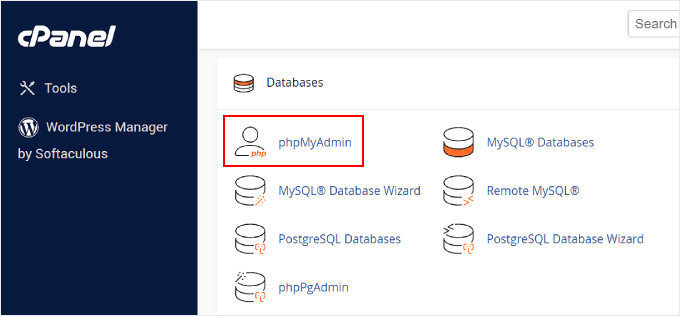
Al hacer clic en el icono se abrirá la interfaz de phpMyAdmin. Necesitas seleccionar tu base de datos de WordPress de la columna izquierda.
Después de eso, phpMyAdmin mostrará todas las tablas en tu base de datos de WordPress. Realizarás cambios en las tablas wp_users y wp_usermeta.
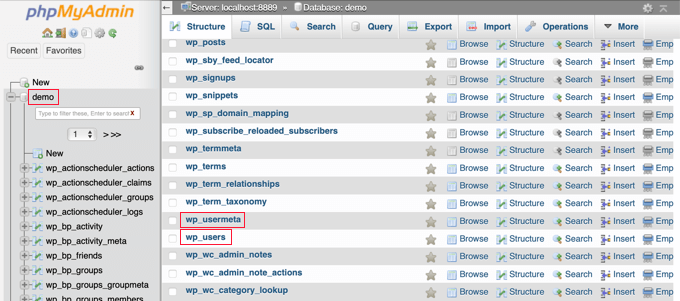
Agregar un usuario a la tabla wp_users
Primero, necesitas encontrar la tabla wp_users y hacer clic en ella. Esto mostrará los usuarios actualmente listados en la tabla.
Observe en la captura de pantalla a continuación que hay dos ID de usuario en la tabla de nuestro sitio de demostración, 1 y 2. Cuando creamos un nuevo usuario para nuestro sitio de demostración, este ID debe ser único, así que escribiremos el número 3.
Necesitas hacer clic en la pestaña 'Insertar' en la parte superior de la pantalla para poder insertar la información de un nuevo usuario administrador.
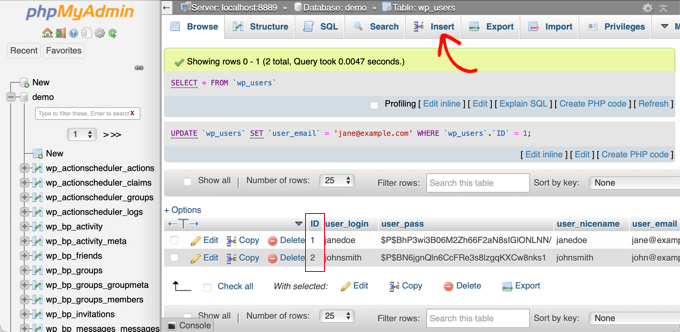
Agrega la siguiente información a los campos del formulario de Insertar:
ID: elige un número único (en nuestro ejemplo, usaremos 3)user_login: el nombre de usuario que se usará al iniciar sesiónuser_pass: agrega una contraseña y asegúrate de seleccionar MD5 en el menú de funciones (ver la captura de pantalla a continuación)user_nicename: el nombre completo o apodo del usuariouser_email: la dirección de correo electrónico del usuariouser_url: la dirección de tu sitio webuser_registered: selecciona la fecha y hora en que se registró el usuario usando el calendariouser_activation_key: déjalo en blancouser_status: configúralo en 0display_name: el nombre completo o nombre para mostrar del usuario
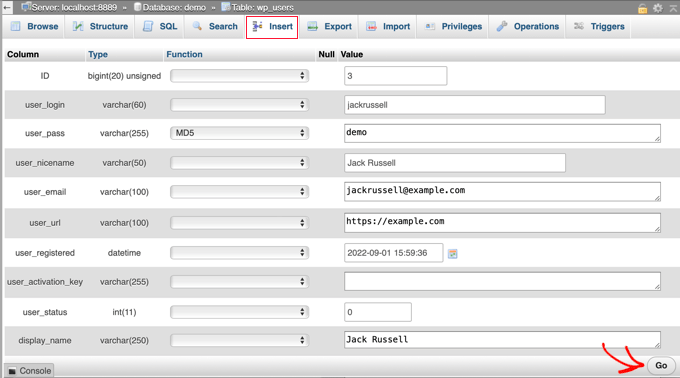
Una vez que hayas terminado, asegúrate de hacer clic en el botón ‘Ir’ para guardar el nuevo usuario.
Agregar un usuario a la tabla wp_usermeta
Ahora, necesitas encontrar la tabla wp_usermeta y hacer clic en ella. Después de eso, deberías hacer clic en la pestaña ‘Insertar’ como lo hiciste en el paso anterior.
A continuación, debes agregar la siguiente información al formulario de inserción:
unmeta_id: deja esto en blanco (se generará automáticamente)user_id: el ID de usuario que usaste en el paso anteriormeta_key: esto debería serwp_capabilitiesmeta_value: inserta esto:a:1:{s:13:"administrator";s:1:"1";}
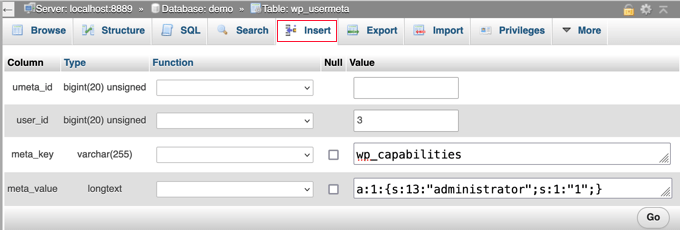
Después de eso, al desplazarte hacia abajo, deberías encontrar campos para una segunda fila. Necesitas agregar la siguiente información:
unmeta_id: deja esto en blanco (se generará automáticamente)user_id: el ID de usuario que usaste en los pasos anterioresmeta_key: necesitas ingresarwp_user_levelmeta_value: 10

Cuando hayas terminado de ingresar la información en los campos, necesitas hacer clic en el botón ‘Ir’. ¡Felicitaciones, has creado un nuevo nombre de usuario administrador!
Ahora, deberías poder iniciar sesión en tu área de administración de WordPress usando el nombre de usuario y la contraseña que especificaste para este usuario.
Tan pronto como inicies sesión, necesitas navegar a Usuarios » Todos los usuarios, luego haz clic en el nombre de usuario que acabas de crear.
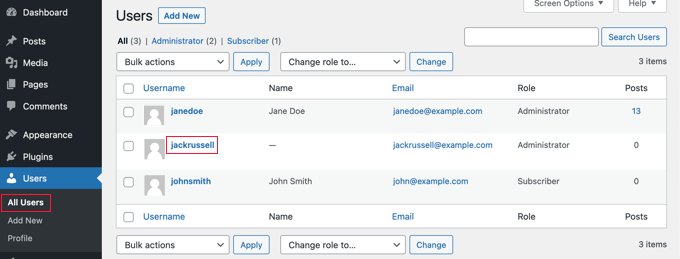
Ahora, sin cambiar nada, desplázate hasta la parte inferior de la página y haz clic en el botón ‘Guardar’.
Esto permitirá que WordPress limpie el usuario que acabas de crear y agregue información adicional que se necesita.
Agregar un usuario administrador a la base de datos de WordPress usando una consulta SQL
Si eres desarrollador, puedes acelerar el proceso usando código.
Simplemente inserta esta consulta SQL en tu base de datos:
INSERT INTO `databasename`.`wp_users` (`ID`, `user_login`, `user_pass`, `user_nicename`, `user_email`, `user_url`, `user_registered`, `user_activation_key`, `user_status`, `display_name`) VALUES ('3', 'demo', MD5('demo'), 'Your Name', 'test@example.com', 'http://www.example.com/', '2022-09-01 00:00:00', '', '0', 'Your Name');
INSERT INTO `databasename`.`wp_usermeta` (`umeta_id`, `user_id`, `meta_key`, `meta_value`) VALUES (NULL, '3', 'wp_capabilities', 'a:1:{s:13:"administrator";s:1:"1";}');
INSERT INTO `databasename`.`wp_usermeta` (`umeta_id`, `user_id`, `meta_key`, `meta_value`) VALUES (NULL, '3', 'wp_user_level', '10');
Asegúrate de cambiar ‘nombrebasedatos’ por la base de datos con la que estás trabajando.
Además, no olvides cambiar los otros valores a los que desees para el nuevo usuario, como explicamos en el primer método.
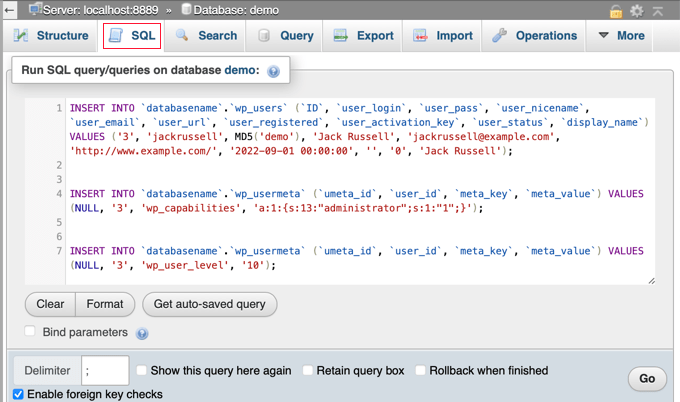
Guías expertas sobre qué hacer cuando te bloquean el acceso al administrador de WordPress
Ahora que sabes cómo agregar un usuario administrador a través de MySQL, quizás te interese ver algunos artículos sobre cómo solucionar tu sitio web cuando te bloquean el acceso al área de administración de WordPress.
- Qué hacer cuando te bloquean el acceso al administrador de WordPress (wp-admin)
- Cómo usar el modo de recuperación de WordPress
- Cómo restablecer una contraseña de WordPress desde phpMyAdmin
- Cómo desbloquear el plugin Limit Login Attempts en WordPress
- Cómo desactivar todos los plugins cuando no puedes acceder a WP-Admin
- Cómo solucionar la pantalla blanca de la muerte de WordPress (paso a paso)
- Cómo solucionar el error crítico en WordPress (paso a paso)
- Cómo solucionar el problema de la página de inicio de sesión de WordPress que se actualiza y redirige
- Cómo Solucionar el Error al Establecer una Conexión de Base de Datos en WordPress
- Cómo solucionar fácilmente el error "Este sitio no se puede alcanzar" en WordPress
Esperamos que este tutorial te haya ayudado a aprender cómo agregar un usuario administrador a la base de datos de WordPress a través de MySQL. También te puede interesar ver nuestra guía definitiva de seguridad de WordPress o nuestra lista de errores comunes de WordPress y cómo solucionarlos.
Si te gustó este artículo, suscríbete a nuestro canal de YouTube para obtener tutoriales en video de WordPress. También puedes encontrarnos en Twitter y Facebook.





zohaib
Muchas gracias, sí, resolví mi problema y esto se debió al rol asignado a mi nombre de usuario. ¡Saludos!
Bichir Mihail
Gracias, muy útil
Rastislav Nichta
Guía realmente muy simple y clara sobre cómo crear un usuario a través de la base de datos de Wordpress MYSQL, gracias.
Mary Janis
Esta información está desactualizada porque el formato HG ha cambiado por completo. ¿Dónde diablos está wp_user?
Susan Marshall VA
Muchas gracias por esto. Acabo de tener una clienta que se quedó fuera de su sitio y pude ayudarla a volver con estas instrucciones.
Kumar Mritunjay
He usado esto en mis sitios web. Funciona a la perfección... ¡muy fácil de seguir!
Gracias por esta increíble técnica para ahorrar tiempo.
sara asadiha
i did everything u said, but it did not work what else should i do?
what else should i do?
Peter Gough
Thanks for this. Really helped when I was locked out of Wordpress
Michael Sineni
Cambié mi acceso de administrador a editor porque estaba intentando cambiar las capacidades del rol para editar gravity forms. De repente, ¡ya no veo editar cornerstone ni tengo acceso! ¡AYUDA!
Ayesi
Muy bueno, todo funciona perfecto, ¡¡mil gracias!!
Stella
¡Muchas gracias! Esto me salvó el día. ¡Uf!
Nilo Velez
No sé si es una actualización de la estructura de datos de WordPress, pero acabo de encontrar un sitio en el que tuve que ingresar los valores de meta_key de wp_options como:
[prefijo_tabla]capabilities en lugar de wp_capabilities
[prefijo_tabla]user_level en lugar de wp_user_level
Dejo esto aquí por si sirve de ayuda.
Takis Pan
¡Usted, señor, es increíble!
Supongo que usa el prefijo de la base de datos, pero en caso de que el sitio se haya movido, o alguien haya cambiado el prefijo de "wp_" a otra cosa, capabilities y user_level deberían cambiarse en consecuencia.
Abraham Quilca
Gracias, este comentario ayudó mucho.
Tuve que verificar dos veces y obtener el valor exacto de table_prefix de nuestro archivo wp-config.php. Nuestros valores de meta_key eran correctos excepto por la capitalización. Creo que algunas empresas de hosting con instalaciones de WordPress de un solo clic establecerán sus propios prefijos de tabla, así que asegúrate de verificar eso también.
Cheryl
esto también funcionó para mí, gracias Abraham
Loren Helgeson
Lo he usado en tres sitios web diferentes hasta ahora. ¡Funciona de maravilla!
Gracias por este increíble ahorro de tiempo.
Steve Day
BRILLIANT!!!
Thank you – saved my day
Kirst
Parece que ha habido un cambio en la base de datos en la versión más reciente de WP, por lo que es posible que esta publicación necesite ser actualizada.
¡Ha sido un recurso increíble, gracias!
Loren Helgeson
No puedo verificar esto con versiones anteriores de Wordpress, pero acabo de probar esto con la última versión de Wordpress, y funcionó bien para mí. ¿Alguien más puede confirmar si fue una casualidad?
Abid
He hecho las mismas consultas SQL para crear un usuario administrador. El usuario se creó e inició sesión, pero muestra el error "Lo sentimos, no tiene permitido acceder a esta página". Por favor, ayúdenme con esto.
Jade
¡MUCHAS GRACIAS! Tuve un problema con WooCommerce Product Vendors, donde me apliqué como proveedor mientras estaba conectado como administrador. A partir de ese momento, no pude iniciar sesión y recibí un mensaje "Se le notificará una vez que su cuenta haya sido aprobada" O_o
Previously I had to re-install WP because of this!!! Now I found your post and it was such a help!!! Thank you so much for sharing this x
x
Ben
No me funcionó para nada. Me sale un “ERROR: Nombre de usuario o contraseña incorrectos.”
Sí, sí, ya lo revisé. La contraseña y el usuario son correctos.
¿Y ahora qué? Solía tener acceso de administrador, pero ahora solo tengo un nivel básico inferior que no muestra la configuración de usuario.
Loren Helgeson
Esto funcionó perfectamente en los dos últimos sitios en los que tuve que usarlo.
SHAILENDRA RAJAVARAM
¡¡¡Genial... me ahorró muchísimos problemas, como con otros asuntos. Vi que por alguna razón todos los administradores de mi sitio se convirtieron en otra cosa...
¡¡¡GRAN AYUDA!!
Los que discutieron sobre los prefijos de wp... perfecto....
¡¡¡Ah!!!
Werner Ullrich
Para mí es una publicación de gran ayuda. He modificado este script SQL y reanimado mi puerta de entrada al administrador de mi página de inicio de WordPress. Gracias.
Werner Ullrich
Smithg0
Está bien, este video de YouTube está mucho más mejorado que el anterior, este tiene una característica de imagen agradable, así como audio.
Jerry L
Quería cambiar varias entradas de "Nicename" por valores distintos al ID de inicio de sesión de ese usuario. Desde PhpMyAdmin, exporté la tabla "wp_users".
Luego hice los cambios necesarios en mi editor de código.
Luego, después de guardar una copia de seguridad de la tabla de usuarios original y de toda la base de datos, "importé" solo la tabla "wp_users" de nuevo en la base de datos usando PhpMyAdmin.
Me funcionó bien.
Brad
¡¡¡Funcionó a la perfección! ¡Gracias!
kali
Seguí esto y pude iniciar sesión, pero no puedo ir al panel de control. Recibo este error: No tienes permisos suficientes para acceder a esta página.
Oleg
Tengo el mismo problema.
Eileen
Tuve el mismo problema pero en wp_usermeta donde se nos dice que escribamos:
meta_value – inserta esto: a:1:{s:13:”administrator”;s:1:”1″;}
Cambié el valor a:
a:1:{s:13:”administrator”;b:1;}
y funcionó. Encontré este valor en el valor correspondiente más arriba en la tabla para la cuenta de administrador original. Revisa tu tabla y mira si hay otros administradores anteriores, y copia el mismo valor (por si acaso difiere del mío).
Mark P
¡Esto me funcionó, gracias!
Ardestani
Funciona, gracias, de verdad gracias
Jason Coleman
This didn’t work for me
Daniel Payne
Para que esto funcione con la última versión de WordPress 4.4.2, tuve que actualizar los nombres de meta_key porque mi instalación de WordPress estaba usando un prefijo de tabla de wp_brnq_ en lugar del prefijo típico wp_.
Rose
¿Qué quieres decir? A mí tampoco me funciona.
Robert Drummond
¡Gracias por esto! Me salvó de un plugin errante que sobrescribió mi registro de administrador en la tabla de usuarios.
Nadia
Actualmente estoy arreglando el sitio web de mi mamá para su propia empresa y soy una especie de "dummy" de WordPress. No pude iniciar sesión correctamente porque me envió la contraseña equivocada. Después de tres intentos fallidos, decía que debía revisar los datos. Mensaje: 'Nombre de usuario o contraseña incorrectos. Por favor, revise sus datos.'
Seguí estos pasos aquí y seguí todos estos pasos con mucha precisión, pero aún así, con mi nuevo nombre de usuario y contraseña, no puedo iniciar sesión. Mi prefijo era diferente a wp_ lo que decía este artículo, así que también cambié el prefijo, pero no puedo avanzar. Ahora estoy bloqueado hasta mañana.
What happened, can someone maybe help me / explain me what I did wrong and how can I fix this. I really promised my mom to build her website, and it needs to be updated really soon!
Joe Harkins
estabas haciendo un gran trabajo paso a paso hasta que llegaste a
“meta_key – esto debería ser wp_capabilities”
¿Qué significa "debería ser" en este contexto? ¿Significa que ya debería decir eso en ese campo, quizás generado por algo anterior? Si no está ahí, ¿qué se requiere?
Hay un campo desplegable a la derecha de meta_key. Ese nombre de archivo “wp_capabilities” no existe como selección. Hay un campo en blanco a la derecha de eso. ¿Pego wp_capabilities ahí? ¿Hay algún valor de ese nombre en algún lugar que deba poner en ese campo?
Y veo más problemas por delante. Usted dice “insertar otra fila”.
Tomo la palabra “insertar” como un verbo. ¿Dónde y cómo lo hago? Ya estoy en la página de Insertar. No hay nada en ella que diga “Insertar nueva fila”.
Mirando más abajo – hasta el final – saltándome la siguiente sección (que me dicen que haga) Veo un campo que dice “Insertar como una nueva fila”.
Pero “insertar una nueva fila” y que me digan que vaya a un campo que contiene la frase “Insertar como una nueva fila” no son lo mismo.
y hay una casilla marcada que dice “ignorar” justo encima. ¿Cuál es el punto de seguir adelante si esa casilla todavía está marcada como ignorar – y “insertar una nueva fila” es lo mismo que “insertar una nueva fila”?
Y veo la misma confusión de “debería ser” de nuevo en el siguiente conjunto de instrucciones.
Pero me quedo atascado en el primer “should” porque soy de mente literal. ¿Podrías aclarar?
Jeff
Hola Joe,
“meta_key – esto debería ser wp_capabilities” significa que el valor de meta_key (el cuadro de texto en phpmyadmin) debería ser wp_capabilities
Cuando se refiere a insertar una nueva fila, puede hacerlo haciendo clic en insertar en la navegación en la parte superior de phpmyadmin. Este tutorial asume que ya ha realizado la primera inserción y está en la pestaña de navegación.
Rich
Tenía una configuración de múltiples sitios. Después de hacer esto, puedo acceder a ambos sitios, sin embargo, no tengo capacidad de Administrador de Red ni gestión de plugins… Debajo de “Mis Sitios” veo mis dos sitios, pero no hay opción de “Red”. En el área del menú vertical para mi sitio, parece que tengo todo excepto “Plugins”.
¿Parece que no tengo administración sobre mi Red de WP para múltiples sitios?
sapere aude
that was awesome! thanks.
thanks.
Bouasone
Muchas gracias, es muy útil
Russ
¡Gracias por el gran tutorial! Pude iniciar sesión correctamente.
Arpan Das
Muchas gracias. Funciona bien…
Rodolfo
¡Esto me salvó la vida hoy – gracias!
Phil
Esto funcionó para mí con la siguiente modificación: el valor de wp_capabilities tuvo que ser tomado de la fila de otro usuario administrador porque tenía permisos adicionales o lo que sea. Copia los valores en ese caso de un usuario existente si es necesario
Reid Walley
Si has seguido todos los pasos y SIGUES recibiendo el mensaje de error “No tienes permisos suficientes para acceder a esta página” al intentar iniciar sesión…
Tuve que reemplazar la primera meta_key de ejemplo (wp_capabilities) con mi propio prefijo: cambia wp_capabilities a whateveryourprefixis_capabilities
Lo mismo con el segundo ejemplo de meta_key (wp_user_level). Lo cambié a mi prefijo específico: cambia wp_user_level a whateveryourprefixis_user_level
Yoana
Thanks, that fixed it
Terry Hale
Such a helpful article. Perfectly done, easy to understand. Thanks for the time you spent putting it together.
Andre
Esto me ha sido de gran ayuda en varias ocasiones. ¡¡¡Gracias por hacer esto!!!
2046
para aquellos que todavía tienen No tienes permisos suficientes para acceder a esta página.
es posible que desees verificar que las wp_capabilities y otras cosas sigan el nombre de tu prefijo de base de datos.
por ejemplo, si normalmente tu wp_usersmeta tiene blab787_usersmeta, las wp_capabilities serán blab787_capabilities, etc.
Lydia B
Gracias, tu solución al mensaje de error “no tienes permisos suficientes” funcionó perfectamente para mí.
Terry Hale
Thanks for posting! I ran into that problem, and you solved it.
Cristian Deraco
¡¡¡Gracias!!! ¡Me funcionó, sí!
Rony
No puedo ver la tabla con la información del usuario, ¿tienes alguna idea?
Denny
Guía fantástica. Esto es exacto con múltiples versiones de phpmyadmin, así que ignora las diferencias en las capturas de pantalla. ¡Gracias por el artículo!
-D
Denny
WordPress 3.6.1. Probaré esto con la versión 4 y lo confirmaré también.
Ludwik C. Siadlak
Lo mismo aquí, en septiembre de 2015 recibo el error “No tienes permisos suficientes para acceder a esta página.” después de usar el código SQL proporcionado. Lo cual es extraño, ¡ya que este artículo tiene solo 6 meses!
Harm
Seguí tus instrucciones al pie de la letra pero algo salió mal (no sé qué) y ahora no tengo acceso a mi sitio web. Me aparece el mensaje: error de base de datos.
¿Puedo deshacer los cambios que hice? Por favor, ayúdame.
Kiel
todo lo que tuve que hacer fue revertir los metadatos a admin y funcionó muy bien. Gracias por el artículo.
Matthew Galvin
Prácticamente inútil en > versión 3. Buen comienzo, sin embargo.
Chris Hewlett
Hola, investigué un poco más el problema y descubrí que las entradas existentes en la tabla “usermeta” tenían un prefijo que era único para mi sitio. Mis tablas de WordPress comienzan con ar_, y una vez que edité esas 2 filas para reflejar eso, mi inicio de sesión se completó, con todos los privilegios.
Saludos,
Chris
Chris Hewlett
Hola y gracias por el artículo anterior sobre este tema. Me han bloqueado de mi sitio local (XAMPP) y otros artículos que he leído tratan sobre cómo cambiar la contraseña del usuario administrador existente usando phpMyAdmin. No tuve éxito con esos métodos.
Seguí tus instrucciones anteriores y la pantalla de inicio de sesión aceptó las credenciales.
Desafortunadamente, fui redirigido a domain//wp-admin/profile.php y apareció la frase “No tienes permisos suficientes para acceder a esta página”.
Desde el front-end del sitio, puedo ver que he iniciado sesión, pero cuando hago clic en Panel, aparece la misma frase.
¿Tienes alguna sugerencia que me permita acceder?
Gracias de antemano,
Chris
Abishai
Hola, intenté la solución siguiendo las instrucciones al pie de la letra, pero cuando intento iniciar sesión: url/wp-admin me lleva a una página url/25/ como antes. Me pregunto qué hice mal. Por favor, avísame. Gracias de antemano.